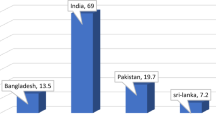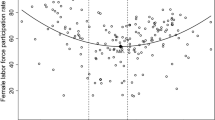Abstract
Important changes are occurring in the Canadian unions’ political and economic environments. This paper argues that such changes may be detrimental to Canadian trade unions, given their structural and institutional situation. To support this argument, private-sector union and nonunion firms in Alberta are compared. This comparison uncovers some structural (union members’ employment patterns and union firm characteristics) and institutional (union services) attributes of unions. Combined with the politico-economic environments that Alberta unions have faced since the early 1980s, these attributes have led to a decline in union membership. Because these attributes are shared by many other Canadian unions, those unions may increasingly confront some of the same hardships currently plaguing their Alberta counterparts.
Similar content being viewed by others
References
Adams, Roy J. “Two Policy Approaches to Labour-Management Decision Making at the Level of the Enterprise.” InLabour-Management Cooperation in Canada, pp. 87–110. Edited by W. Craig Riddel. Ottawa, ONT: Minister of Supply and Services, 1986.
Alberta Labour.An Examination of Labour-Management Communication Provisions in Collective Agreements and Third Party Investigations (Phase 1). Edmonton, AB: Planning and Research Branch, December 1987.
_____.Membership in Labor Organization in Alberta, 1984, 1985 & 1986. Edmonton, AB: Planning and Research Branch, 1985–1987. 3 issues.
_____.Negotiated Working Conditions in Alberta: Collective Agreements 1986. Edmonton, AB: Planning and Research Branch, 1986.
Bernstein, Aaron. “Help Wanted.”Business Week, August 10, 1987, pp. 48–53.
Borgen, Fred H. and Mark J. Seling. “Uses of Discriminant Analysis Following MANOVA: Multivariate Statistics for Multivariate Purposes.”Journal of Applied Psychology 63 (1978): 689–97.
Bureau of National Affairs, February 11, 1988.
Cappelli, Peter and John Chalykoff. “The Effects of Management Industrial Relations Strategy: Results of a Recent Survey.”Proceedings of the 38th Annual Meeting, Industrial Relations Research Association. Madison, WI: IRRA, 1985, pp. 171–78.
Craig, Alton W. J.The System of Industrial Relations in Canada. 2d ed. Scarborough, ONT: Prentice-Hall, 1986.
Financial Post, October 26, 1987, p. 6.
Freeman, Richard B. and James L. Medoff.What Do Unions Do? New York: Basic Books, 1984.
Gibb-Clark, M. “Courts Viewing Bosses More Favorably in Dismissal Suits.”The Globe and Mail, November 30, 1987, p.B11.
Gunderson, Morley and Noah M. Meltz. “Canadian Unions Achieve Strong Gains in Membership.”Monthly Labor Review 109 (April 1986): 48–49.
Katz, Harry C.Shifting Gears: Changing Relations in the U.S. Automobile Industry. Cambridge, MA: MIT Press, 1985.
_____ and Charles, F. Sabel. “Industrial Relations and Industrial Adjustments in the Car Industry.”Industrial Relations 24 (Fall 1985): 295–315.
Klecka, William R.Discriminant Analysis. Beverly Hills, CA: Sage, 1982.
Kochan, Thomas A.Collective Bargaining and Industrial Relations. Homewood, IL: Irwin, 1980.
_____, Robert B. McKersie, and John Chalykoff. “The Effects of Corporate Strategy and Workplace Innovations on Union Representation.”Industrial and Labor Relations Review 39 (July 1986): 487–501.
Kochan, Thomas A., Harry C. Katz, and Robert B. McKersie.The Transformation of American Industrial Relations. New York, NY: Basic Books, 1986.
Kumar, Pradeep. “Union Growth in Canada: Retrospect and Prospect.” InCanadian Labour Relations, pp. 95–160. Edited by W. Craig Riddell. Ottawa, ONT: Minister of Supply and Services, 1986.
_____, Mary Lou Coates, and David Arrowsmith.The Current Industrial Relations Scene in Canada, 1987. Kingston, ONT: Industrial Relations Centre, Queen’s University, 1987.
Languedoc, Colin. “Entrepreneurs Pick Labor Headaches.”The Financial Post, December 1, 1986, p. 21.
Meltz, Noah. “Labor Movements in Canada and the United Sates.” InChallenges and Choices Facing American Labor, pp. 315–34. Edited by Thomas A. Kochan. Cambridge, MA: MIT Press, 1985.
Fanitch, Leo V. and Donald Swartz.The Assault on Trade Union Freedoms. Toronto, ONT: Garamond, 1988.
Reisman, Barbara and Compa Lance. “The Case for Adversarial Unions.”Harvard Business Review 63 (May–June 1985): 22–36.
Riddell, W. Craig. “Labour-Management Cooperation in Canada: An Overview.” InLabour-Management Cooperation in Canada, pp. 1–56. Edited by W. Craig Riddell. Ottawa, ONT: Minister of Supply and Services, 1986.
Rose, Joseph B. and Gary N. Chaison. “The State of the Unions: United States and Canada.”Journal of Labor Research 6 (Fall 1985): 97–111.
Statistics Canada.Corporations and Labour Unions Returns Act. Part 2. Ottawa, ONT: Minister of Supply and Services, 1987–1988, 2 issues.
Statistics Canada.Small Business in Canada: A Statistical Profile. Ottawa, ONT: Minister of Supply and Services, 1985–1987. 3 issues.
The Edmonton Journal, November 20, 1987, p. A1.
Thomspon, James D.Organizations in Action. New York, NY: McGraw-Hill, 1967.
Walker, Julian.First Agreement Disputes and Public Policy in Canada. Research Essay Series No. 12. Kingston, ONT: Industrial Relations Centre, Queen’s University.
Williams, C. Brian. “Trade Union Structure and Philosophy: Need for Reappraisal.” InCanadian Labour in Transition, pp. 145–72. Edited by R. U. Miller and F. Isbester. Scarborough, ONT: Prentice-Hall, 1971.
Zeytinoglu, Isik U. “Part-Time Workers: Unionization and Collective Bargaining in Canada.”Proceedings of the 39th Annual Meeting, Industrial Relations Research Association. Madison, WI: IRRA, 1986, pp. 487–95.
Author information
Authors and Affiliations
Additional information
I am indebted to Brian Bemmels, Alan Murray, and John G. Fricke for helpful comments on an earlier version of this paper, and to Mike Jones for his research assistance.
Rights and permissions
About this article
Cite this article
Reshef, Y. Union decline: A view from Canada. Journal of Labor Research 11, 25–39 (1990). https://doi.org/10.1007/BF02685418
Issue Date:
DOI: https://doi.org/10.1007/BF02685418




